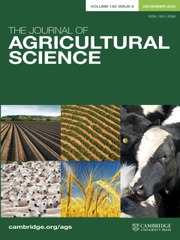The Journal of Agricultural Science is one of the few journals that is truly interdisciplinary and multidisciplinary, publishing articles related to crop and animal physiology; modelling of crop, animal and integrated crop–livestock systems; the scientific underpinning of agronomy and husbandry; animal welfare and behaviour; soil science and soil health; plant and animal product quality; plant and animal nutrition; engineering solution; decision support systems; land use; environmental impact of agriculture; agroforestry systems and forestry as it relates to agriculture; carbon sequestration; impacts of climate change; climate change adaptation and mitigation; climate-smart agriculture; rural biodiversity; experimental design and statistical analysis and the application of new analytical and study methods, including genetic diversity and molecular biology approaches.
Based on the 2023 Journal of Citation Reports distributed annually by Clarivate Analytics, The Journal of Agricultural Science ranks 32 out of 89 in the Multidisciplinary Agriculture category with an impact factor of 1.7. This compares to an impact factor of 2.0 in 2022. The Cite Score in 2023 was 2.8, with a Cite Score of 2.4 for 2022.
The Journal of Agricultural Science is committed to improving the visibility of the articles that are published in the journal. Each month up to two papers are selected for highlighting, one representing the Crops and Soils articles and one representing Animals and Livestock articles. We encourage the authors of the selected articles to provide a brief summary in the form of a blog post, written in common language, to help disseminate the outcomes of their research. Recently published blog posts include ‘A tale of two chickens; Understanding the physiological and transcriptomic differences associated with bodyweight in broilers’ by Cormac O'Shea (https://www.cambridge.org/core/blog/2024/12/13/a-tale-of-two-chickens-understanding-the-physiological-and-transcriptomic-differences-associated-with-bodyweight-in-broilers/); ‘Bridging the Yield Gap: Lessons from Brazil to Boost Maize Production in Sub-Saharan Africa’ by Fábio Marin (https://www.cambridge.org/core/blog/2024/12/16/bridging-the-yield-gap-lessons-from-brazil-to-boost-maize-production-in-sub-saharan-africa/); ‘Sainfoin: A Climate-Resilient Super Forage for the Future’ by Anis Sakhraoui (https://www.cambridge.org/core/blog/2024/12/17/sainfoin-a-climate-resilient-super-forage-for-the-future/) and ‘Energy supplementation of beef steers or inclusion of legumes in temperate pastures in crop–livestock integration area’ by Luís Glasenapp de Menezes (https://www.cambridge.org/core/blog/2024/07/31/energy-supplementation-of-beef-steers-or-inclusion-of-legumes-in-temperate-pastures-in-crop-livestock-integration-area/). We encourage our readers to visit the blog posts on a regular basis at https://www.cambridge.org/core/blog/tag/the-journal-of-agricultural-science/.
We would like to acknowledge the important role of the Editorial Board in identifying reviewers and collecting review responses for a final recommendation to the Editors-in-Chief. It really has become very challenging to find qualified reviewers. We, therefore, would like to encourage our authors to seriously consider accepting a review invitation when they are selected by one of the Editors. As we did not publish an editorial in 2024, we would like to recognize the Editors who ended their duties in both 2023 and 2024. We would like to thank Diego Rubiales (Crops & Soils, November 2017 to December 2023); Bruno Pedreira (Crops & Soils, April 2022 to December 2024); Bronwyn Barkla (Crops & Soils, January 2013 to December 2024); Vivek Kuttappan (Animals, July 2017 to December 2023); Joao Daniel (Animals, November 2022 to October 2023); Sameer Pant (Animals, July 2022 to July 2024) and Gonzalo Cantalapiedra-Hijar (Animals, October 2016 to October 2024). We welcomed nine new Editors in total in 2023 and 2024: for Crops and Soil Science, Rafael Battisti (Universidade Federal de Goiás, Brazil); Mauricio Fernandes (Embrapa, Brazil); Margarita Garcia-Vila (Consejo Superior de Investigaciones Científicas (CSIC), Spain) and in January 2025, we also welcomed Abmael Cardoso (University of Wisconsin, USA). For Animals, Xianyong Lan (Northwest A&F University (NWAFU), China), Arda Yildirim (Tokat Gaziosmanpaşa University, Türkiye), Egon Horst (State University of Londrina, Brazil), John Otto (The University of Newcastle, Australia) and Gaëlle Maxin (UMR 1213 Herbivores INRAE-VetAgroSup, France). We also would like to welcome Professor Sokratis Stergiadis (University of Reading, UK) as our incoming Editor-in-Chief for Animals. Sokratis had kindly agreed to take on this very important role of managing all papers related to Animals and Livestock, stepping up from his previous role on the Editorial Board. He will be replacing Professor Julian Wiseman (University of Nottingham, UK), who will be retiring in March 2025 as Editor-in-Chief for Animals.
We also recognize the importance of the reviewers and the academic service they provide to the scientific community. Without their support we would not be able to publish any papers in The Journal of Agricultural Science. The Supplementary file attached to this Editorial lists the 2023 and 2024 Reviewers with their affiliations and countries again demonstrating the global nature of the journal. We are, as always, indebted to all those who give their time and expertise voluntarily.
The Editors-in-Chief are very grateful for the dedicated service and commitment of the staff of Cambridge University Press.
We would like to remind authors that help with the Manuscript Central ScholarOne site is always available. In addition to journal-specific on-screen instructions as you go through the submission process, there are also general resources available by clicking the Help button near the top right of the ScholarOne screen. This opens the ScholarOne Manuscripts Support page, where you can find resources tailored to your role, including FAQs, videos and even training sessions. You can also email the journal office ([email protected]) for journal-specific help and advice.
With the journal now being online only, Accepted Manuscripts are now available online as soon as the authors have completed the necessary paperwork, with a DOI assigned for easy reference. Accepted Manuscripts can be found at https://www.cambridge.org/core/journals/journal-of-agricultural-science/accepted-manuscripts. Following typesetting, these manuscripts are then moved to First View Manuscripts that can be found at https://www.cambridge.org/core/journals/journal-of-agricultural-science/firstview.
We really appreciate the support and interest provided by our readers as well as by those who submit and publish their research outcomes in The Journal of Agricultural Science. We are looking forward to further streamlining and improving the submission, review and publication process to the benefit of the scientific community we serve.
Supplementary material
The supplementary material for this article can be found at https://doi.org/10.1017/S0021859625000103.



